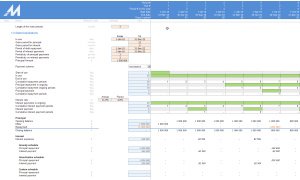
Debt Schedule models Start the discussion!

What is a Debt Schedule?
A debt schedule is made to lay out the debt that a business has accrued based on its maturity. A debt schedule is commonly used by businesses to build a cash flow analysis. In the debt schedule, interest expense flows into the income statement.
The total of closing debt balances also flows into the balance sheet. The debt schedule is a supporting schedule, and it is one of the schedules that ties together the three financial statements.
Components of a Debt Schedule in a Financial Model
Most of the time, an analyst will have to build a supporting schedule that outlines interest and debt when they are building a financial model in Excel.
A debt schedule is made up of:
-Opening balance
-Draws
-Repayments
-Interest Expense
-Closing balance
These components allow tracking of the debt until maturity. From the schedule, the closing balance flows back to the balance sheet, and the interest expense flows to the income statement.
Type of Debt is Listed in a Debt Schedule
All debt that is currently owed by a business must be included in the debt schedule. The types of debt included are:
- Leases
- Loans
- Debentures
- Bonds
Things to be Considered in the Construction of a Debt Schedule
Before deciding to go ahead and borrow money, it’s important that the company carefully considers whether or not it is able to repay debt, as well as evaluating the real cost of the debt. Companies need to consider the following factors:
- Debt maturity – The majority of debt is paid monthly and amortized. The longer the maturity of the debt is, the less amount of money is due monthly, but the higher the interest accrued and the total sum of the debt.
- Interest rate – Usually, the lower the interest rate is, the better. For a long-term debt, a low interest rate generally results in a higher interest than a short term debt with the high interest rate. It’s the investor that will need to calculate the total interest.
- Floating or fixed interest – The overall debt amount will be changed each year if there is a floating interest rate, whilst you will have a reliable calculation if there is a fixed interest rate. It depends on the future assumption, but generally a floating interest rate is the better option in a declining or low interest rate environment.
- Ability to generate gain – If the debtor is not able to pay the debt off via a steady stream of income for example, then there is no reason to take on new debt. If you cannot pay off your debt, it may result in a loss of trust and forced liquidation.
Why is a Debt Schedule Important?
Usually a debt schedule is made because once a debt matures, it’s useful to be able to estimate the total amount of money that a company has to pay. A debt schedule is also used so that the company can monitor the maturity of the debt, which is then used to make decisions. An example of a decision made based on debt maturity would be considering the refinancing of debt through a different source or institution when the interest rate declines.
As well as this, the debt schedule report is able to be used to negotiate a new line of credit for the business. Lenders will consider the balance between risk and reward using the report before they grant a new credit.
If you'd like to read more about Debt Schedules, visit:]
Most popular models
 Powerful, highly customization and free debt calculations module.3,0271add_shopping_cart$19.00
Powerful, highly customization and free debt calculations module.3,0271add_shopping_cart$19.00 by Alex Martyanov
by Alex Martyanov

Lender Business Model (UNLOCKED)
Enables Lender or Creditor to compute loan originations, payouts, and loan sales. Displays up to 4 borrower profiles.982Discussadd_shopping_cart$54.00 by ExcelModels
by ExcelModels

Debt/Loan Refinancing Analysis Excel Tool
User-friendly Excel tool to calculate financial impacts of refinancing a portfolio of debt/loan facilities1,952Discussadd_shopping_cart$35.00 by Projectify
by Projectify

Loan Schedule
A flexible tool to calculate loan balances and accrued interest559Discussadd_shopping_cart$10.00 by Andrei Okhlopkov
by Andrei Okhlopkov

Enhanced Debt/Loan Refinancing Analysis Excel Tool
User-friendly Excel tool to calculate financial impacts of refinancing a portfolio of debt/loan facilities3571add_shopping_cart$39.00 by Projectify
by Projectify

Debt/Loan Analysis Excel Template Bundle
Debt/Loan analysis model bundle combining 3 templates at a 25% discount compared to their separate list prices717Discussadd_shopping_cart$65.00 by Projectify
by Projectify








